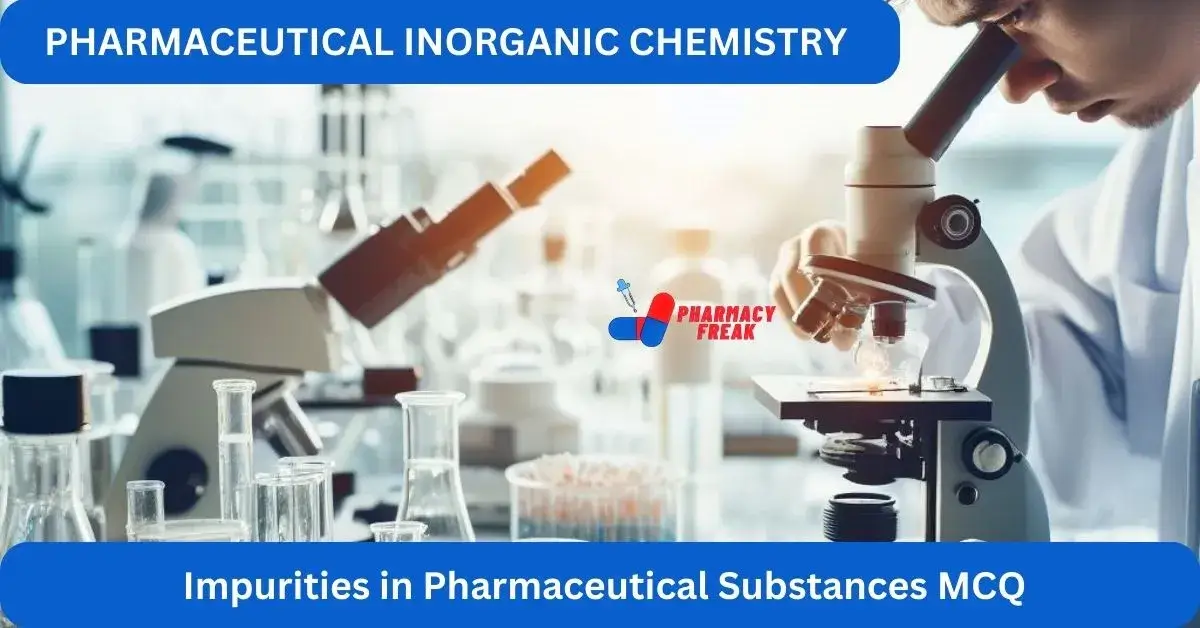We have provided MCQs on Impurities in pharmaceutical substances, Unit-1, 1st semester, PHARMACEUTICAL INORGANIC CHEMISTRY, B. Pharm.
We have covered following topics.
Impurities in pharmaceutical substances: History of Pharmacopoeia, Sources and types of impurities, principle involved in the limit test for Chloride, Sulphate, Iron, Arsenic, Lead and Heavy metals, modified limit test for Chloride and
Table of Contents
MCQ on Impurities in Pharmaceutical Substances
Which of the following is the oldest pharmacopoeia in the world?
- A. London Pharmacopoeia
- B. Chinese Pharmacopoeia
- C. Indian Pharmacopoeia
- D. United States Pharmacopeia
Answer: B
Which of the following pharmacopoeias is published by the World Health Organization (WHO)?
- A. International Pharmacopoeia
- B. European Pharmacopoeia
- C. Japanese Pharmacopoeia
- D. United States Pharmacopeia
Answer: A
Which of the following pharmacopoeias is published by the United States Pharmacopeial Convention (USP)?
- A. International Pharmacopoeia
- B. European Pharmacopoeia
- C. Japanese Pharmacopoeia
- D. United States Pharmacopeia
Answer: D
Sources and types of impurities
Which of the following is the most common source of impurities in pharmaceutical substances?
- A. Raw materials
- B. Manufacturing process
- C. Packaging
- D. Storage
Answer: A
Which of the following is not a type of impurity in pharmaceutical substances?
- A. Inorganic impurities
- B. Organic impurities
- C. Residual solvents
- D. Microbial impurities
Answer: D
Which of the following organic impurities is formed during the synthesis of aspirin?
- A. Salicylic acid
- B. Acetic anhydride
- C. Salicylic anhydride
- D. Acetic acid
Answer: C
Which of the following inorganic impurities is commonly found in pharmaceutical substances?
- A. Heavy metals
- B. Chlorides
- C. Sulphate
- D. All of the above
Answer: D
Which of the following residual solvents is limited in pharmaceutical substances by the ICH Q3C guideline?
- A. Water
- B. Ethanol
- C. Methanol
- D. Toluene
Answer: C
Limit tests for impurities
What is the principle of the limit test for chloride using silver nitrate?
- A. Chloride ions form a white precipitate with silver nitrate.
- B. Chloride ions form a yellow precipitate with silver nitrate.
- C. Chloride ions form a red precipitate with silver nitrate.
- D. Chloride ions form a black precipitate with silver nitrate.
Answer: A
What is the principle of the limit test for sulphate using barium chloride?
- A. Sulphate ions form a white precipitate with barium chloride.
- B. Sulphate ions form a yellow precipitate with barium chloride.
- C. Sulphate ions form a red precipitate with barium chloride.
- D. Sulphate ions form a black precipitate with barium chloride.
Answer: A
What is the principle of the limit test for iron using ammonium thiocyanate?
- A. Iron ions form a red precipitate with ammonium thiocyanate.
- B. Iron ions form a yellow precipitate with ammonium thiocyanate.
- C. Iron ions form a white precipitate with ammonium thiocyanate.
- D. Iron ions form a black precipitate with ammonium thiocyanate.
Answer: A
What is the principle of the limit test for arsenic using Gutzeit’s test?
- A. Arsenic forms a yellow stain on silver nitrate paper.
- B. Arsenic forms a red stain on silver nitrate paper.
- C. Arsenic forms a black stain on silver nitrate paper.
- D. Arsenic does not form a stain on silver nitrate paper.
Answer: C
What is the principle of the limit test for lead using the sulphide test?
- A. Lead ions form a black precipitate with hydrogen sulphide.
- B. Lead ions form a yellow precipitate with hydrogen sulphide.
- C. Lead ions form a red precipitate with hydrogen sulphide.
- D. Lead ions do not form a precipitate with hydrogen sulphide.
Answer: A
What is the principle of the limit test for heavy metals using the sulphide test?
- A. Heavy metal ions form a black precipitate with hydrogen sulphide.
- B. Heavy metal ions form a yellow precipitate with hydrogen sulphide.
- C. Heavy metal ions form a red precipitate with hydrogen sulphide.
- D. Heavy metal ions do not form a precipitate with hydrogen sulphide.
Answer: A
Modified limit tests for chloride and sulphate
What is the advantage of the modified limit test for chloride over the traditional limit test using silver nitrate?
- A. It is more sensitive.
- B. It is less specific.
- C. It is less expensive.
- D. It is easier to perform.
Answer: A
What is the principle of the modified limit test for chloride?
- A. Chloride ions form a white precipitate with silver nitrate in the presence of nitric acid.
- B. Chloride ions form a yellow precipitate with silver nitrate in the presence of nitric acid.
- C. Chloride ions form a red precipitate with silver nitrate in the presence of nitric acid.
- D. Chloride ions form a black precipitate with silver nitrate in the presence of nitric acid.
Answer: A
What is the advantage of the modified limit test for sulphate over the traditional limit test using barium chloride?
- A. It is more sensitive.
- B. It is less specific.
- C. It is less expensive.
- D. It is easier to perform.
Answer: A
What is the principle of the modified limit test for sulphate?
- A. Sulphate ions form a white precipitate with barium chloride in the presence of hydrochloric acid.
- B. Sulphate ions form a yellow precipitate with barium chloride in the presence of hydrochloric acid.
- C. Sulphate ions form a red precipitate with barium chloride in the presence of hydrochloric acid.
- D. Sulphate ions form a black precipitate with barium chloride in the presence of hydrochloric acid.
Answer: A
More MCQ
PHARMACEUTICAL INORGANIC CHEMISTRY
